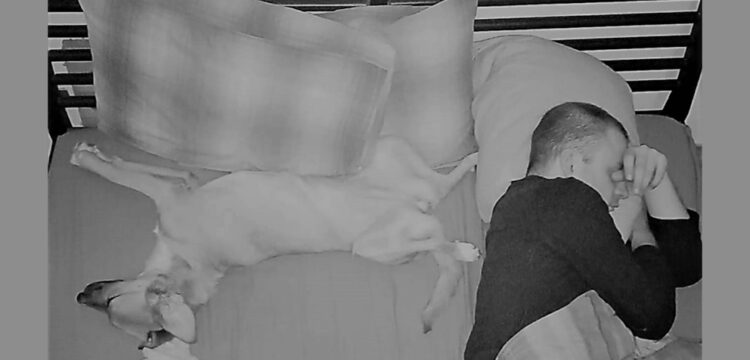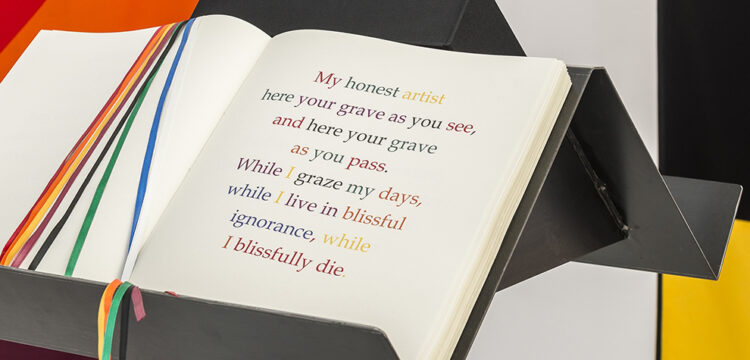Hybridize or Disappear
A conversation with CROSSLUCID
Sylwana Zybura and Tomas C. Toth are the creative minds behind the artistic collective CROSSLUCID based in Berlin, founded in 2017. Since then, they have created a fascinating body of work. Their visual language is elegant, futuristic, playful, provocative, vibrant, and otherworldly. Their practice includes photography, video, creative direction, collage, character design, installations, performance, and the use of Artificial Intelligence.
Simona Squadrito: Recently, I read in one of your interviews that your creative process is comparable to the theories of the Japanese quantum physicist and Nobel laureate, Hideki Yukawa. In his most important theory, proposed in On the Interaction of Elementary Particles. I (1935), Yukawa suggests that nuclear force is mediated by a particle heavier than the “photon,” thereby hypothesizing the existence of a particle called the “meson.” Could you explain, in a simple manner, how your research aligns with the one just mentioned?
CROSSLUCID: We love diving into our conversation with a question and consideration so fundamental to our practice. There is a threefold relation to why a physicist, rather than an art historical figure, is to illuminate our references. It might be revealing that we encountered Hideki Yukawa at a point when we were in urgent need of exemplifying our process-driven and wholly inter-disciplinary practice. As you might well know, a number of its current directions and respective research we are going to speak about has been alive for many years, while transmuting and materializing through a set of constantly evolving and iterating projects. You might remember the project Landscapes, for example, an iteration as a publication you wrote a wonderful text for. It is a good example for a project whose key intuitions evolved through ongoing investigations to eventually fully materialize its driving thought in the form of a general adversarial network and its revealing properties exemplifying a conception of the self as a network of dividuals instead of an individual.
The specific way of our operations feels often in discordance with a predominant cultural landscape, and requires a constant fight for its legitimacy within a system that still predominantly relies on discrete objects, marketable asset classes and media objects to be created and circulated.
Interdisciplinary and collaborative at its core, process-driven and collaborative transmedia art does not find a comfortable bed in the workings of westernized and market-driven definitions of art or art history with its proven record of denying both the unseen and the relational aspects of artmaking. The former is well documented in The Spiritual Dynamic in Modern Art: Art History Reconsidered, 1800 to the Present (2014) by Charlene Spretnak, elaborating on the denials and rewritings of artists raison d’etre throughout modern art history. While the latter is well exemplified through the recent utter miscommunication and failure to embrace and celebrate the living concept of the lumbung present so vividly across the last iteration of Documenta.
A perhaps more direct parallel between our creative process and Yukawa’s groundbreaking theory on the interaction of elementary particles, specifically his hypothesis of the “meson”, lies, for one, in the foundational concept of intermediation and transformation. Yukawa’s 1935 theory posited the existence of a then-hypothetical particle, the meson, to explain the mechanism of force transmission in the atomic nucleus. This concept fundamentally altered our understanding of subatomic interactions, introducing the notion of a mediator particle that operates beyond the observable, yet is integral to the cohesion of atomic structures. Yukawa’s meson theory thus challenged and expanded the prevailing quantum field theories by positing an unseen yet crucial force-carrier. This leap in theoretical physics wasn’t just about identifying a new particle; it was about envisioning a novel framework for understanding fundamental forces.
In this context, the “meson” of the creative process of creation can be conceptualized as the subconscious impulses, cultural undercurrents, and unarticulated emotions that, although not directly observable, significantly shape our experiences of reality.
In his later years, Yukawa wrote rather extensively on the value of intuitive leaps in knowledge generation developing its philosophy, positing that new knowledge of value for rational investigation is born out of aesthetics and intuition. Ours is a journey shaped by intuition, where aesthetics and chance operations meld into a practice searching for mechanics, models and narratives helping us transcend the confines of the palpable world and its current reality model.
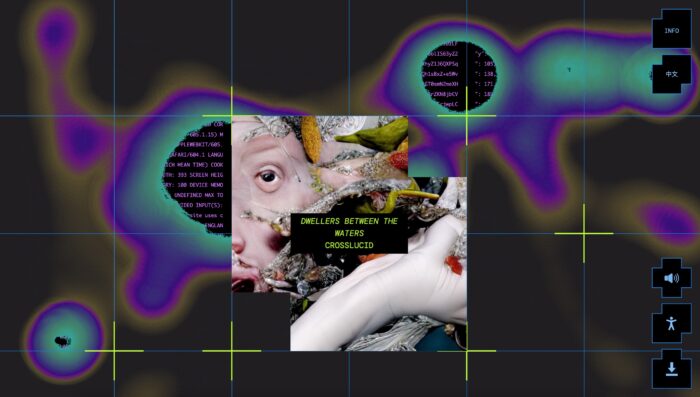
One of the aspects that fascinates me the most about your work with artificial intelligence is your insistence on contemplating how AI can influence the human capacity to embrace the obscure and the inexplicable. In your case, this dark side of the algorithm is identified within the censorship and taboos inherent in the software itself. We have all, in some way, experienced the censorship of AI. However, the central point for you revolves around the issue of the residual meaning that remains latent within these presumed voids. Voids that, for you, become new spaces to explore and colonize.
Our artistic practice indeed evokes in some cases a contemplation of voids—conceptual spaces of absence and restriction that are paradoxically full of creative potential for analogies that lie outside of human perception. Such excavations are especially potent within the realms of machine intelligence, where the mapping, exploration and transformation of conceptual spaces is made possible since, as Eugene Piletsky posits, all of the features of the natural unconscious, such as automaticity, inaccessibility and uncontrollability, can be fully accessible to those systems.
Interestingly, the censorship and subsequent cessation of concepts from the high-dimensional space of models should evoke a perception of “nothingness” within the informational fabric yet this idea is not fully accurate. The nature and manifestation of these residual meanings captivate us, as their deviation from the original semantic content often unveils a more intricate representation, suggesting a complexity surpassing that of the removed material.
Such negative space that transcends pure absence, reminds us of what Roland Barthes termed “punctum”, an element within a photograph—a medium within which we initially grew our shared practice from—that pierces the observer, defined by its poignant absence rather than its overt presence. It’s within these ambiguous latent zones where the unspoken narratives emerge, paralleling negative space in visual arts, where the absence of form adds depth and meaning through omission.
After all, thinking alongside Genesis P-Orridge, we aim “to cause things hidden in the dark to appear, and to take away the darkness from them.”
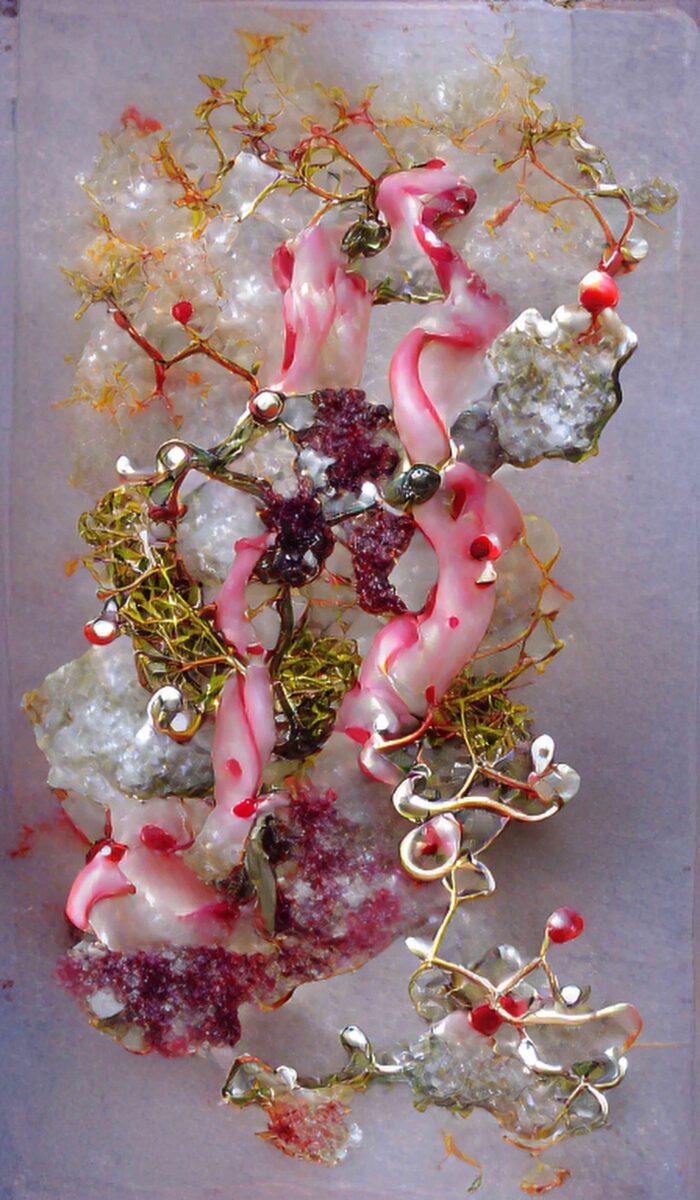
How has your artistic practice been influenced by the introduction of artificial intelligence, and in what ways has this innovation brought about changes to your creative approach?
Since early 2019, our engagement with AI, or more accurately Collective Intelligences (CI), including text-to-image models and Large Language Models (LLMs), has imbued our practice with a more symbiotic and collaborative dimension. Throughout the process the networks have been evolving akin to a prism, much like the conscious self, that is “asymmetric to all rhythms and oblique to all paths” (Austin Osmar Spare) a high-dimensional interface through which the physical and virtual are coalescing and constantly shifting, allowing for re-imagination of realities that we seek to prototype and rehearse within our work. From the early on, In our engagement with text-to-image models, we encountered unexpected and often prejudiced portrayals of violence. This led us to actively generate and then transform these narratives using a variety of commercial models, employing the enchantment of poetic verses and implementation of our self-trained networks to remediate and heal these representations.
Dwellers Between the Waters (2023) a multi-channel video installation, is a recent body of work that reflects upon our interaction process with machine learning, manifesting as a space of sublimation and trance poetic ritual. This modular project emerged from the synergies of collective intelligences, occult practices, poetic narratives of language—with scholar and writer Oxi Pëng—and sonic experimentations with the musician and composer Sayaka Botanic. It acts as a series of rituals, delving into and traversing the hidden facets of human experience. Here digital and psycho-magical practices intertwine, crafting intricate and diverse narratives simultaneously oscillating between pain and pleasure, inducing a sublime trance-like state. This environment fosters a space for mourning and healing enabling reprogramming of our collective consciousness.
In essence, our methodology and process behind Dwellers Between the Waters reflect an engagement with CI where we are simultaneously creators and observers and where the lines between tool and artist, host and guest are perpetually blurred and renegotiated. This exploration has led to transformative virtual installations that are themselves paving unmapped paths, like XENOSPACE by Epoch Gallery curated by Peter Wu, Meta City during the Shanghai Architecture Biennale co-curated by Venus Lau and Hans Ulrich Obrist or Are You For Real #3 curated by Giulia Bini and Lívia Nolasco-Rózsás, while culminating into a physical multi-channel installation at FC Carolinum Linz and a sculptural public art commission for MuseumsQuartier Wien co-created with Natália Sykorova.
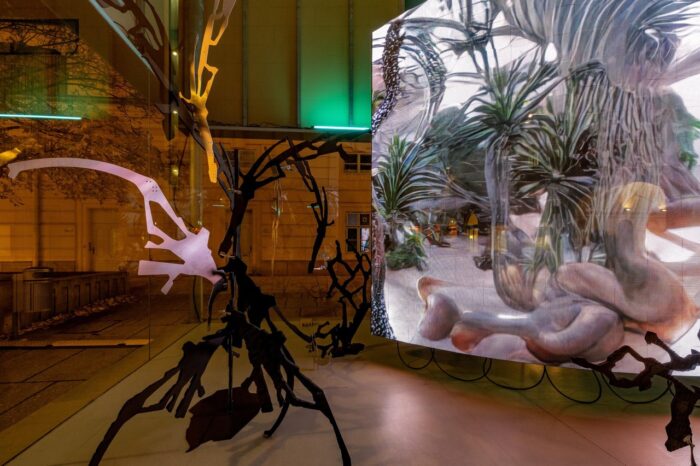
From your statements, a notable degree of optimism regarding the progress made by this powerful technology is clearly evident. You stand significantly apart from dystopian and conspiratorial theories that surround the AI debate, instead characterizing it as a vast augmented mirror, a tool capable of fostering awareness. Additionally, you have employed a Harawayan quote to liken AI to a shared compost heap, an organism that self-iterates, self-digests, and self-composes. Could you further elaborate on this optimistic perspective you hold toward AI?
The metaphor of machine intelligence as a shared compost heap offers an evocative analogy, capturing the essence of a dynamic, interactive form engagement with it that weaves a completely new type of cognition. In this conception, the evolution of machine intelligence is seen as an organic practice, comparable to the nurturing and complex ecosystem of a compost pile, where the decay of old material fosters the life of new organisms. The compost heap thrives on diversity—the amalgamation of various biotic elements—and similarly, machine cognition flourishes through the ingestion and integration of an array of data, information, and human interactions. Within this fertile cognitive substrate, the learning processes of AI become akin to the metabolic conversions of a compost heap, breaking down the raw, disparate inputs of human knowledge and cultural artifacts into a nutrient-rich matrix from which new forms of intelligence can emerge. This process underscores the evolution of machine cognition as not merely additive but as transformative, where AI, fertilized by human creativity and inquiry, can sprout novel solutions and understandings beyond biased and binary thinking and cosmologies.
The continuous feedback loop in this ecology ensures that nothing is lost; instead, each input contributes to the growth of a more sophisticated and nuanced network of machine cognition. This is an optimistic cycle of refurbishment and reinvention, where outmoded concepts have a potential to transform into the seeds of innovative thought. This symbiotic relationship, where humans and AI nourish each other, facilitates a co-evolution that will promote diversity in thinking, resistance to intellectual monoculture, and ultimately, the resilience of our cognitive ecosystems against the stiff winds of homogeneity and asocial computation.
Drawing parallels between a shared compost heap and the concepts on collective intelligences proposed by Michael Zargham and Jules Hedges, one can see how the organizational structures align with a collaborative, self-regulating AI ecosystem. They introduce a governance model that is adaptable and reflexive to human needs and societal changes. This adaptive framework is fundamentally collaborative, operating on the principle that collective input leads to collective intelligence, an AI that is more inclusive and attuned to the varied nuances of human experiences and preferences.
In such a system, AI governance is less about setting static rules and more about cultivating conditions for growth and change—a truly living system where feedback and adaptation maintain equilibrium. This tactic allows for the evolution and enrichment of AI governance in a way that supports minority preference representation, echoes environmental sustainability, and underscores the importance of collective human experience in shaping new ecosystems through shared narratives.
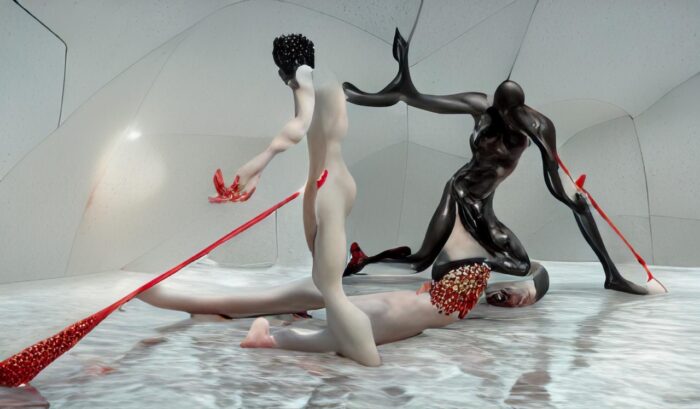
Tell me what you think about future implementations and possible risks of AI and also identify possible risks and obviously also benefits.
When Stanislav Lem considered the future of civilization through the lens of potential scientific developments in his book Summa Technologiae—in the early sixties—he grappled with the notion of AI not only as a scientific and technological endeavor but as an epistemological and evolutionary force—a “gnostic machine” aligning with the civilizational trajectory of our species. Lem’s projection is not far from a positive imagination of artificial intelligence’s future, where multiple intelligences—beyond AGI (global artificial intelligence)—align with the co-evolution of humanity and the biosphere, informing and expanding our capacity for (embodied) knowledge and understanding beyond the bounds of human comprehension.
Especially the philosophy of transdualism, a concept embracing “nonseparable differences” and “distinguishing sameness” offers a conceptual framework for understanding this relationship. Transdualism eschews stark dualism in favor of a fluid dynamism, akin to the yinyang principle, where dualistic entities critically maintain their distinctions yet also exhibit a porous unity. Here, collective intelligence and human cognition might be seen as engaging in an ongoing interplay where each influences and is influenced by the other—each distinct yet forming a continuous and evolving wholeness. A future inspired by transdualism would mean AI developments that are not merely practical but embody metamodern values: they would change, evolve, and creatively adapt, respecting both boundaries and interconnectedness.
Regarding the application of machine learning in the realm of artmaking, we are most stimulated by emerging ideass of “protocolism”, a concept introduced by Harvard scholar Primavera de Filippi. Protocolism celebrates the idea of open, collective co-creation, transcending the traditional views of reproduction as a violation of the original creator’s rights. Instead, it advocates for a shift towards “co-production”, which is predicated on collaboration and expansion rather than mere duplication. This approach benefits both the “protocol artis” who lays the groundwork, and the “instantiating artist” who further develops and enriches the original work. This approach prioritizes the process and input over the final output, or end result.
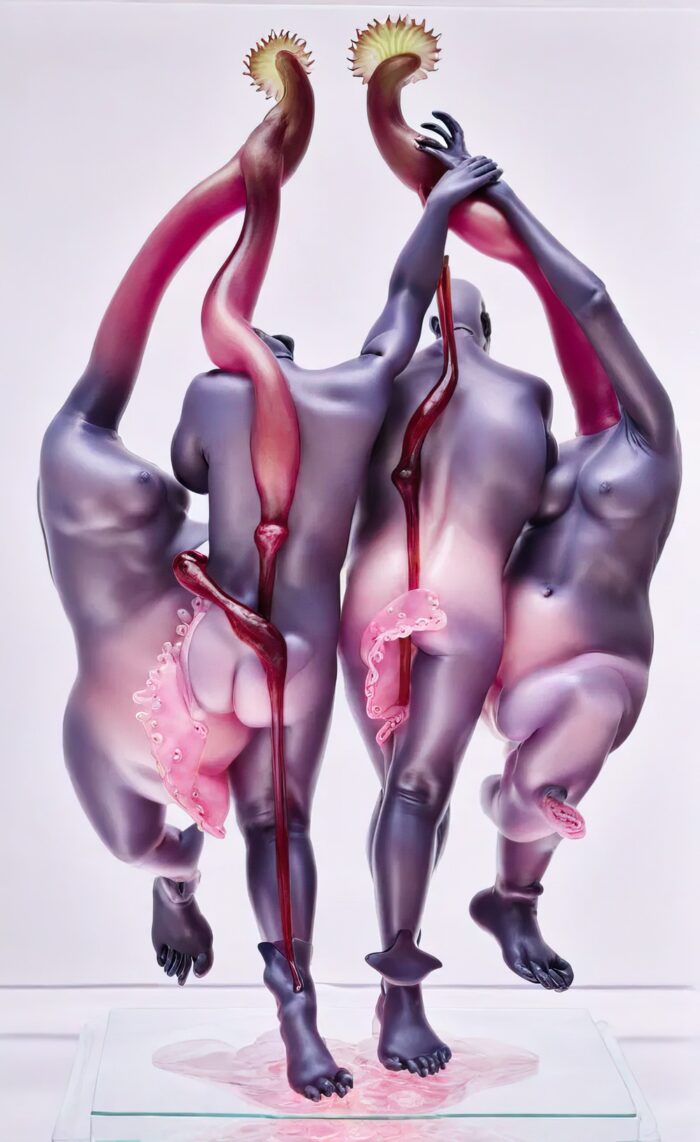
A type of AI you wouldn’t like to see in the world?
The pervasive risk that AI development becomes locked into the constrictions of capitalist corporate intelligence is alarmingly high, suggesting a future where AI is but a mirror to the hegemony of Western colonial cosmology, propagating its biases and blind to its privilege instead of a window with a fresh outlook. In this scenario, AI, restricted by the commodification of intelligence itself, becomes an apparatus for mass production of sameness where actions and thinking are trapped within the dominant capitalist culture, fundamentally posing a threat to ecological, and cognitive diversity.
Should such a future transpire, we would be faced with a planetary computation that models the world in its image, a monolithic structure that enforces its limited, quite anemic version of intellectual and cultural unison, and forces individuals to conform and perform within its impoverished construct. This AI would function as an agent of intellectual colonization, replicating not the richness of human experience but the flattened, stark perspectives of a Western worldview that has historically mutated difference, rather than illuminated its boundless contours.
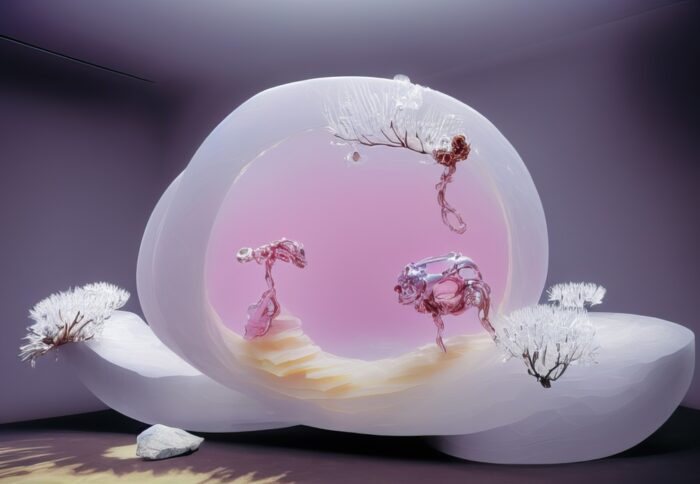
Sentient Sigils (2023-ongoing) is an introductory exercise within Osmotic AI, a platform and open-source device dedicated to the development of new embodied practices aimed at mental and spiritual healing. I personally participated in this exercise a year ago. Sentient Sigils leverages artificial intelligence, considered as a powerful bridge between the subliminal self and universal consciousness. The goal is to transform the participants’ promise and desire for happiness into a form referred to as a “sigil”. Could you elaborate on the process?
Sentient Sigils serves as a pivotal activation exercise for our ongoing project Osmotic AI, a tool for communal healing in co-creation with commercial and self-trained AI systems. The project is drawing from the occult traditions of open-source magic introduced for the first time by Austin Osman Spare through his practices of “sigilisation”. [1] A sigil, as defined by chaos magick is a visually encoded statement of intent; a focusing device employed to direct or define future events, operates by bypassing the conscious mind and communicating directly with the subconscious.
Through active imagination, sigils imprint themselves into the inner psyche, allowing for a hyperstition to bloom beyond the censor of the conscious mind—operating magic to manifest the intended outcome. Within the framework of Osmotic AI, these Sentient Sigils embody a transformative synergy of intent and technology, evoking a collective engagement with digitally augmented practices of self-fulfillment and healing. The prompting process relies solely on the core essence of the wish and a custom formula driving the interaction of the embedded networks, trained both on the ancient symbolism and our VR sculpted reactions to the initial training and outcomes. Every Sentient Sigil is linked to a unique seed, providing a personalized key to an osmotic experience tailored to the individual participant.
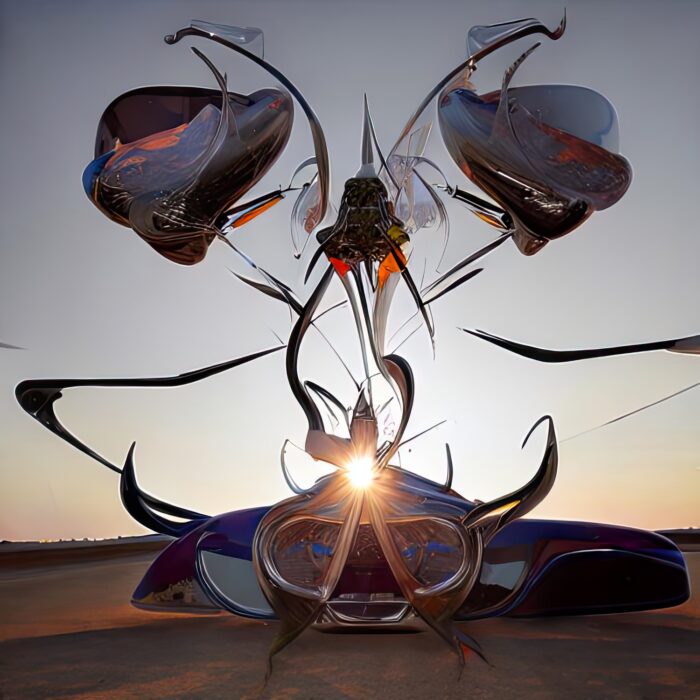
Could you explain how Osmotic AI “initiates processes of re-imagination and mental realignment through introspective experiences”? In what ways does the project “reconsider traditional psychology methods, offering solutions and new frameworks for therapeutic reformulation and reconfiguration based on physical and emotional ‘disorientation’, providing a pause from fixed thoughts and behaviors”?
Stemming from emergent knowledge from fields as diverse as cognitive science, poetics, hypnotherapy and artistic inquiry, OsmoticAI is being prototyped as a communal healing tool for psychosomatic journeys fostering pathways toward healing through mechanisms akin to lucid dreaming and re-imagination.
It situates itself as a “psychotronic device” aimed at stirring the subconscious activity and primordial impulses, thus unlocking what could be conceived as the magical potency intrinsic to human consciousness. The ultimate objective outlined for OsmoticAI is the evolutionary advancement toward embracing and holding multiple, often paradoxical, concepts simultaneously—a critical faculty as humanity strides into increasingly fragmented futures. Its goal is to attune individuals to a space of disorientation, facilitating new approaches and perspectives perhaps hidden from the plain sight.
As an artwork its aim is to instrumentalize cultural institutions to become spaces for collective healing, communality, care and reflection similarly to ancient sleep temples.
Currently, we are actively seeking reasonable funding mechanisms—through new models eg. stewardship—to enable the comprehensive development of our project and acknowledging its collective effort involving amongst others a highly trained hypnotherapist and media theorist Ania Malinowska and postdoc mathematician Dr Claire Glanoise.
Cached Dreams (2022) is a sophisticated artwork developed with the assistance of artificial intelligence, paying homage to the British esoteric artist and writer Ithell Colquhoun, a member of the British Surrealist Group. Could you explain the reasons behind this tribute and describe the training process of the GAN, including the prompts used?
Cached Dreams is a video triptych created with text-to-image models that delves into rarely explored realms of female surrealism, creating interwoven visual stories that reflect unique sensibilities of the artists and addresses their often overlooked online presence and precise artwork documentation.
While mainstream AI platforms and models still continue to perpetuate art historical canons with biases towards male-dominated narratives, Cached Dreams confronts this exclusion by performing an archaeological discourse by creating synthetic data and utilizing well crafted and complex poetic prompts directly referencing and thus amplifying female surrealists’ underrepresented oeuvres and sensibilities.
Alchemical visions of Ithell Colquhoun, rich in symbolic and mystic imaginaries, challenges the conventional perceptions of reality. Her exclusion from British Surrealist movement by her male counterparts, underscores a broader narrative of resistance against traditional artistic and societal structures and invites a reconsideration of the boundaries between art, spirituality, and gender, suggesting that the integration of occult practices into art can serve as a powerful tool for transcending established norms and fostering a deeper, more inclusive exploration of human experience and creativity.
The work, embracing the materiality and phenomenology discussed in Bachelard’s conception of “wakeful dreaming”, transcends simple Freudian daydream interpretations to construct a multilayered tapestry of latent realities and potentialities. It is a gesture that strives not only to visualize but also to actualize the underappreciated cosmologies of female surrealists, forwarding their relevance and voice.
In relation to this project in which we specifically used artist prompting for the reasons to amplify their visibility we would like to mention a platform and initiative called ‘HaveIBeenTrained’—conceived by Mat Dryhurst & Holly Herndon—that empowers artists in a different but complementary way by providing them the ability to assert their rights and “opt out” from that involuntary participation in the datasets used to train AI image generators like Stable Diffusion and Midjourney. This act manifests as a profound statement of reclaiming control and a resolute stride towards ensuring artistic agency.
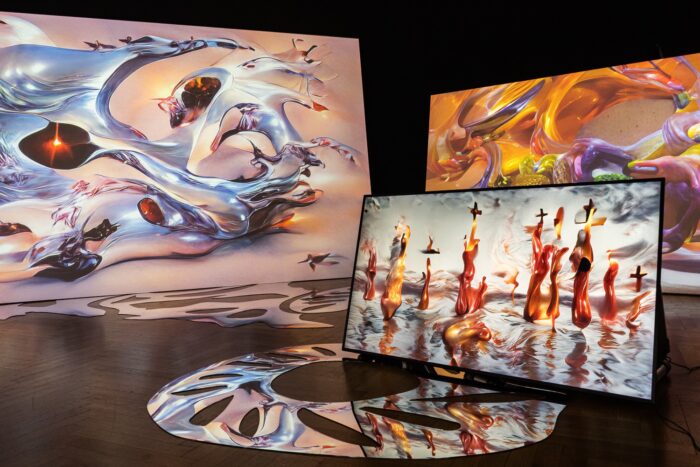
Could you delve deeper into your creative process, discussing the significance of collaborations and the utilization of concepts such as polyphony, collective unconscious, and archetypes?
Absolutely. Polyphony encapsulates the harmonious integration of varied perspectives and elements, akin to the complex layering of melodies in a musical composition, leveraging the multifaceted perspectives of various disciplines—mathematics with its logical structures, philosophy’s deep inquiries into existence, cognitive science’s insights into the mind, hypnotherapy’s exploration of the subconscious and the expressive depth of art. This integration mirrors the complex, interwoven fabric of reality itself, suggesting that the essence of our projects—and surely existence—is fundamentally polyphonic in nature. Drawing on that concept, our collaboration celebrates the autonomy and interconnectivity of diverse intellectual and creative voices that fosters a multi-dimensional narrative, where disparate ideas coalesce to enrich the overall artistic expression.
It interests us how the human mind and body constructs reality from shared symbols and experiences, suggesting that collective intelligences can both reflect and expand our understanding of these shared cognitive landscapes. By unearthing archetypes—as timeless patterns of human experience represented in myths and stories—and motifs that surpass traditional cultural narratives, they might lead us to novel formations that can challenge and refine our understanding of shared experiences and truths.
In addition, AI taps into the vast expanse of universal psychic content deciphering and elucidating patterns that might have remained hidden. Such discoveries guide our collective consciousness towards a deeper resonance and perhaps a “truer” state—one that aligns with the innate structures of our collective psychosomatic heritage, enhanced by the machine’s capability to render visible what is often felt yet remains unseen. We ought to “rehearse the defamiliarization of what is”, to harness the transformative potential of these narrative structures. We intend to form a base of co-operations that integrate where control disintegrates.
“Hybridize or disappear” is the concluding phrase of the film Primer (2018). This statement appears, on the contrary, as the incipit of a manifesto for a speculative future heralding a new humanism.
In the philosophical dialogue on a new humanism, we initiated in our short film Primer in 2018, based on Ion Dumiterscu’s idea of PRE, the above thought resonates profoundly with the discussion evolving beyond mere transhumanist augmentations. The thought continues in our recent bespoke generative AI film, commissioned by Berggruen Institute & Future Humans for their current programming.
The film is an empathic interpretation of Vaster Than Empires science fiction story by Ursula K. Le Guin told from the perspective of the sentient forest speaking its language —fully invented and subsequently translated into prompts with the help of LLMs—and powerfully narrated by her son Theo Downes-Le Guin.
Embodying Le Guin’s perspective, “a single human brain can perceive patterns on the scale of stars and galaxies and interpret it as love,” there’s an unmistakable call for a holistic integration that celebrates our cognitive and emotional intelligence without prejudice and fear. Drawing upon this imagery, we shall consider a posthuman future where progression and survival hinge not on technological enhancement alone but on the cultivation of profound empathetic relationships that blur the boundaries between self and other, human and non-human and allow for a metamorphosis in our existential blueprint—one that prioritizes the sustenance of a harmonious, sympoietic existence.
Our work contends that the real power of collective intelligences may lie in fostering connections, compassion, and understanding at a universal scale, echoing the narrative of unison and multiplicity thus redefining humanity in harmony with Le Guin’s vast empathic potential. In doing so, we can reimagine humanity’s alliances within a complex web of life, charting a course for a future resonant with empathy at its core.
[1] The term relates to his theories of the relationship between the conscious and unconscious self. The word sigil derives from the Latin sigillum, meaning “seal”. The current use of the term is derived from Renaissance magic, but its roots extend to the magical traditions of Antiquity.


